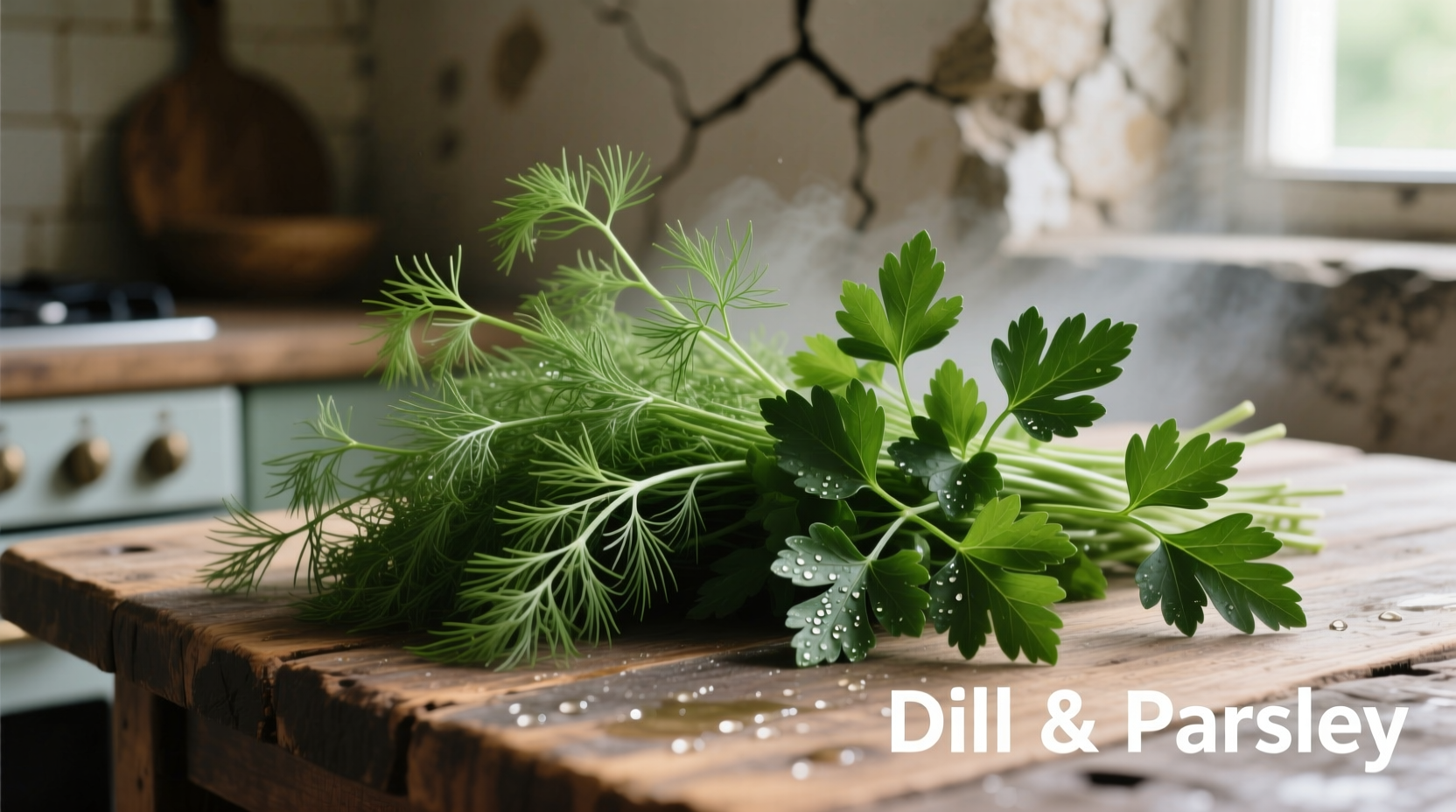Spotting the Difference: Visual Identification
Before using these herbs, you need to identify them correctly. While both appear green and leafy, key visual differences exist:
| Characteristic | Dill | Parsley |
|---|---|---|
| Leaf Shape | Feathery, delicate fronds resembling fennel | Broad, flat or curly leaves with defined edges |
| Stem Structure | Thin, hollow stems that branch frequently | Thicker, solid stems with less branching |
| Color | Lighter, yellowish-green hue | Darker, richer green color |
| Height | Grows taller (up to 4 feet) | Shorter growth habit (typically 1-2 feet) |

Flavor Profiles: More Than Just Green Leaves
Understanding the flavor chemistry helps you use these herbs effectively. Dill contains carvone and limonene compounds that create its distinctive grassy-anise flavor, while parsley's apiol and myristicin provide a cleaner, slightly peppery taste with citrus undertones.
Food science research from the USDA Agricultural Research Service shows that dill's flavor compounds are more volatile and dissipate faster during cooking compared to parsley's more stable compounds. This explains why dill works best added at the end of cooking or in cold preparations, while parsley can withstand moderate heat.
When to Use Each Herb: Culinary Applications
Professional chefs follow specific guidelines for optimal herb usage based on centuries of culinary tradition:
Dill's Best Applications
- Fish and seafood dishes - particularly salmon, trout, and shellfish
- Pickling and brines - essential for traditional dill pickles
- Cold sauces and dips - tzatziki, ranch dressing, and remoulade
- Vegetable preparations - especially with cucumbers, potatoes, and carrots
- Scandinavian and Eastern European cuisine - where dill has historical significance
Parsley's Best Applications
- Finishing dishes - adds freshness to soups, stews, and roasted meats
- Mediterranean cuisine - key component in gremolata, chimichurri, and tabbouleh
- Salads and vegetable dishes - particularly with tomatoes, beans, and grains
- Herb blends - essential in fines herbes and bouquet garni
- Garnishing - both flat-leaf (better flavor) and curly (decorative) varieties
Substitution Guidelines: When You Can Swap Them
Many home cooks wonder if they can substitute one for the other. The answer depends on context:
| Scenario | Substitution Possible? | Recommendation |
|---|---|---|
| Cold dishes (salads, dips) | Limited | Use 1:1 ratio but expect flavor difference |
| Hot dishes (soups, stews) | Rarely advisable | Parsley holds up better to heat than dill |
| Fish preparations | Not recommended | Dill's anise notes complement fish uniquely |
| Mediterranean cuisine | Not recommended | Parsley is fundamental to these flavor profiles |
| Pickling | Never | Dill is essential for proper flavor development |
According to culinary research documented by the Encyclopædia Britannica, dill has been used in pickling since ancient Roman times, while parsley became prominent in European cuisine during the Middle Ages. This historical context explains why certain dishes fundamentally require one herb over the other.
Storage and Freshness Tips
Proper storage extends the life of both herbs significantly:
For Dill
- Trim stems and place in a glass with 1 inch of water
- Cover loosely with a plastic bag
- Store in refrigerator for up to 10 days
- Never freeze dill - it loses flavor and texture
For Parsley
- Wrap in slightly damp paper towel
- Place in airtight container in refrigerator
- Lasts 1-2 weeks when stored properly
- Can be frozen for cooking applications (not garnishing)
The USDA National Agricultural Library confirms that proper storage can extend herb freshness by 50-100% compared to improper methods. Temperature control between 32-36°F (0-2°C) with high humidity provides optimal preservation.
Nutritional Comparison
Both herbs offer health benefits beyond flavor:
- Dill - rich in vitamin C, manganese, and calcium; contains antioxidants like rosmarinic acid; traditionally used to aid digestion
- Parsley - exceptionally high in vitamin K (one tablespoon provides 20% of daily value); excellent source of vitamin C and folate; contains apiin with potential anti-inflammatory properties
Research published in the National Center for Biotechnology Information indicates that both herbs contain compounds that may support cardiovascular health when consumed regularly as part of a balanced diet.











 浙公网安备
33010002000092号
浙公网安备
33010002000092号 浙B2-20120091-4
浙B2-20120091-4